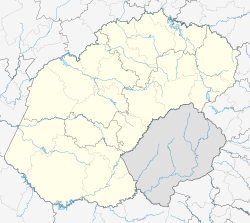|
Parys
Parys (pronounced /ˈpɑːreɪs/) is a resort town in northern Free State province, South Africa. It is situated on the southern bank of the Vaal River.[3] The name is the Afrikaans translation of Paris. The origin of the name 'Parys' is attributed to German surveyor Schilbach, who named it after the city of Paris because of the similarity between its location next to the Vaal River and that of Paris on the River Seine. The area of Parys also includes the two townships of Tumahole and Schonkenville. HistoryIn the early 1870s, towns in the Northern Free State were situated very far apart, and members of different churches had to travel great distances to participate in religious services. It was then decided by the Ring of the Dutch Reformed Church to implant the idea of a congregation north of the Rhenoster River into the minds of the residents of the farm Klipspruit, on the Vaal River, which was owned by four van Coller brothers.
20th century The completion of the railway sideline to Parys in 1905 meant that Parys had suddenly become more accessible to the public, and this led to the growth of the town as a holiday resort and industrial centre. The town was now being marketed as The Pride of the Vaal," and city dwellers flocked by train to the lush green riverbanks and special swimming facilities and accommodations provided by the Village Management Board at the time. Bungalows were built on Woody Island and were serviced by the Woody Island Ferry. Unfortunately, this venture did not last very long because of the inaccessibility of the island during the flood periods. By now, residents of the town had felt for quite some time that a bridge across the Vaal River was justly due. The Woody Island, Ferry Service crossed on to Woody Island and from there another ferry completed the crossing. The service was infrequent, and accidents happened frequently. Farmers on the Transvaal side even preferred to go to Potchefstroom, 48 kilometres (30 mi) away, rather than face the expense of the ferry crossings. Towards the end of 1913, tenders were requested for a reinforced concrete bridge over the Vaal. The project began in May 1914. The outbreak of the First World War three months later caused long delays, and the bridge was only finished and opened for traffic around Christmas 1915. Because of the bridge over the Vaal, trade grew, and Parys was a new market for farmers from the then-Transvaal side. Many new buildings were built as more and more traffic ran through the town.  Few of the original buildings and historic places remain today. The current Parys Palm Court Hotel is one of the surviving turn-of-the century buildings, as are the museum (once the magistrate's office) and "Moedergemeente" Church in the centre of town. There are, however, a few original old houses remaining. Industries that have come and gone are the Orange River Canning Company, Parys Basket Works, which used a special willow planted on the riverbanks, a jam factory, a boat building factory, a cold drink factory, and the Parys Roller Milling Company. By the middle 1950s, big industries like ARWA, BASA (a nuts-and-bolts factory), Vaalrivierse Tabakkooperasie, Vetsak (an agricultural co-op that was founded in Parys), and Metro Clothing Company had settled in the industrial area of Parys. Only a handful of industries remain today, and like in the early days, the town is becoming increasingly popular as a weekend and holiday destination for people wanting to escape the pressures of city life. Notable citizens
References
External linksWikimedia Commons has media related to Parys. |
||||||||||||||||||||||||||||||||||||||||||||||||||||||||||||||||||||



